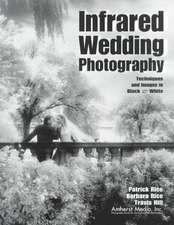The Complete Guide to Photographic Composition
Autor Tony Worobiecen Limba Engleză Paperback – 26 sep 2013
Preț: 158.95 lei
Nou
Puncte Express: 238
Preț estimativ în valută:
30.42€ • 31.90$ • 25.32£
30.42€ • 31.90$ • 25.32£
Carte disponibilă
Livrare economică 11-25 martie
Preluare comenzi: 021 569.72.76
Specificații
ISBN-13: 9781446302637
ISBN-10: 1446302636
Pagini: 159
Ilustrații: 200 colour illustrations
Dimensiuni: 209 x 276 x 13 mm
Greutate: 0.68 kg
Editura: David & Charles Publishers
ISBN-10: 1446302636
Pagini: 159
Ilustrații: 200 colour illustrations
Dimensiuni: 209 x 276 x 13 mm
Greutate: 0.68 kg
Editura: David & Charles Publishers
Notă biografică
Tony Worobiec has won awards for photography in the UK and internationally and he has had work exhibited in London's Barbican Gallery and Bradford's National Museum of Photography. He is a founder member and current chairman of the Arena group of photographers and is a Fellow of the Royal Photographic Society and a former member of that society's Distinctions Panel for Visual Arts. Tony's work has appeared in many photographic magazines both in the UK and the USA. Tony lives in Dorset.
Cuprins
Section 1. Conventional compositional techniques A. What is composition? An introduction 1. What is Composition? 2. Consider how the rules of photography have been drawn from art 3. The Golden Section and the "rule of the thirds" 4. The Golden Spiral 5. The Golden Triangle B. Exploring the viewpoint 1. Understand the each scenario offers different viewpoints 2. Consider the vantage point C. How to organise interacting shapes and forms 1. Organising shapes 2. Balancing Elements 3. The dominant and the subordinate element 4. The Fulcrum. 5. Composing from a corner 6. Organising elements at opposite ends 7. The Multifaceted design 8. Positive and negative shapes D. How line can help structure a composition 1. Line in Composition 2. Perspective and the lead-in line 3. The power of the diagonal line 4. The aesthetic appeal of the "flowing" line 5. The visual "full-stop" E. Foreground/ background 1. Examine strategies for linking the foreground and background 2. The foreground mimicking the background 3. A suitable background 4. Create a sense of scale F. The numbers game 1. Selecting a single focal point / area of greatest tonal contrast 2. Working with pairs 3. When highlighting multiples, use an odd number 4. Crop at the edge to suggest more 5. Matching numbers G. The Value of Colour 1. The Psychology of Colour 2. Creating impact using complimentary colours 3. The aesthetic values of harmonies 4. Advancing and receding colours 5. Monochromatic colour 6. A splash of colour 7. Harmonies H. Consider the edge 1. Using natural frames to direct the eye 2. Ensure that elements face into the picture 3. Print in the edges/vignetting I. Patterns in composition 1. Consider the cohesive qualities of pattern 2. The broken or interrupted pattern 3. Exploiting Texture J. Facing Inwards K. Exploring Texture Section 2. Achieving style through composition A. Improving the structure of the image 1. The Central Meridian 2. Nearly Central 3. Understand how the choice of Format affects composition 4. Manipulating Tonal Values using HDR 5. Knowing when to crop 6. Manipulating scale and proportion 7. Create a visual "palindrome" 8. The mirrored or reflected image 9. Proportion B. Less is more 1. In shades of Grey; using a very restricted palette 2. Tonal recession and aerial perspective 3. High Key/ Low Key 4. Understanding the virtue of the empty space 5. Minimalism 6. The visual appeal of the silhouette 7. In splendid isolation C. Using photographic techniques to improve composition 1. Explore the background 2. The illuminated focal point 3. Increasing emphasis by reducing the depth of field 4. Composition and the "critical moment" D. How art influences photography 1. Explore abstract elements 2. The arabesque line 3. Rhythms in the composition 4. The Graphic image 5. Viewing the same place 6. The Resonating image 7. Text and composition Section 3. A fresh look at composition A. Alternative techniques 1. A shape within a shape/ circle in a square 2. The created composition e.g. the kaleidoscope 3. The negative of a positive 4. Counter-change 5. Creating Translucent layers 6. Sequences and related images 7. Seeing order out of chaos 8. Stalactites" and "stalagmites" 9. The role for serendipity 10. The "constructed" image B. Composing for disharmony 1. The Imperfect Composition 2. The Sloping Horizon 3. Celebrate the ugly 4. The distressed image 5. Anti Composition 6. The edge of the frame 7. The divided image 8. So how do we compose? 9. Just break the "rules" 10. Conclusion; Eidetic images and the Gestalt Theory















